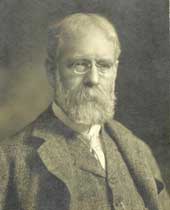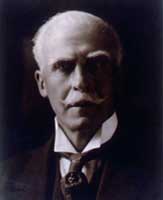 In 1906, the house in which John Keats died was finally bought outright for the Keats-Shelley Memorial Association. This is the story of how that came about.
In 1906, the house in which John Keats died was finally bought outright for the Keats-Shelley Memorial Association. This is the story of how that came about.
In 1903 the rooms in which Keats and Severn had lived were occupied by a pair of American writers,
Mrs James Walcott Haslehurst and her mother, who spent much time permitting the curious to see
where Keats had spent his last days. The house was in a dreadful condition and the
women wanted
to buy it so that it could be restored and preserved as a shrine, but did not have enough money. In February 1903 Robert
Underwood Johnson, an American poet, walked down the Spanish Steps to
look at the house in which Keats had died. He noticed its bedraggled
appearance, entered, and
made enquiries. He then called together a dozen of the American literati resident in Rome, one
prominent Englishman, and their spouses.

The Englishman, Rennell Rodd, (who later saved the graves of Keats and Shelley in the city’s Non-Catholic Cemetery), was a poet as well as a brilliant diplomat. He took the Chair of the meeting. The Americans present were Robert Underwood Johnson and his wife Katharine, Norman Hapgood, Agnes Repplier, James Herbert Morse and his wife Lucy Gibbons, Harry Nelson Gay and Martha Gilbert Dickinson. Edith Wharton was unable to attend but gave the scheme her blessing. Johnson proposed that committees in the United States, England and Italy should raise money for the project; Rennell Rodd led the drive in the United Kingdom, Johnson in the United States and Nelson Gay in Italy. They worked hard, with support from President Roosevelt and King Edward VII, and after three years their efforts were rewarded.
 An option to buy the house was acquired and taken up on the 30th of December 1906 by a cash payment of $14,000 and a mortgage of $8,000. The formal dedication by the King of Italy, Vittorio Emanuele III, took place on 3 April 1909 and was attended by descendants of the poets, the American Ambassador Lloyd Griscom, Sir Rennell Rodd, Rudyard Kipling, Adolpho de Bosis (a young Italian Shelleyan), and Nelson Gay.
An option to buy the house was acquired and taken up on the 30th of December 1906 by a cash payment of $14,000 and a mortgage of $8,000. The formal dedication by the King of Italy, Vittorio Emanuele III, took place on 3 April 1909 and was attended by descendants of the poets, the American Ambassador Lloyd Griscom, Sir Rennell Rodd, Rudyard Kipling, Adolpho de Bosis (a young Italian Shelleyan), and Nelson Gay.
It now contains one of the finest reference libraries of Romantic literature in the world as well as a unique collection of manuscripts, paintings, sculpture and memorabilia. In addition to being a museum and library the House plays an important part in the cultural life of Rome organising lectures, art exhibitions, poetry recitals and gala events.
Among those who occupied rooms in the House after Keats was the Swedish writer and doctor Axel Munthe who lived here at the end of the nineteenth century. An edition of his famous work The Story of San Michele together with a note on his life and friendship with the great Italian actress Eleonora Duse are part of the museum collection.






